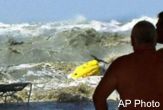Tsunami Special Report

The earthquake and tsunami of Dec. 26, 2004 combined to create a disaster in Asia that is among the worst in recorded history. Though significant tsunamis are rare, it was not the first event of its kind.
Tsunamis have proven incredibly deadly in the past. In 1896 a tsunami caused 27,000 deaths in Japan. A combination of earthquake, fire and tsunami centered around Lisbon, Portugal killed 60,000 people in 1755.
Just two weeks before the Asian catastrophe, scientists revealed the threat of a megatsunami in the Pacific Ocean that could be triggered by a subsea landslide. In recent days, other researchers warned of the potential for a 9.0-magnitude earthquake and tsunami that could hit the West Coast of the United States. There is a warning system in the Pacific, and now officials in India plan to set one up. Also, the United States now is planning to set up a global tsunami warning system.
Tsunamis from near-shore earthquakes can begin striking a coast within minutes, however.
For a tsunami triggered by an earthquake in the Cascadia fault zone off the U.S. West Coast, some residents would have about 15 minutes to get to high ground, says Robert Yeats, professor emeritus of geosciences at Oregon State University.
Should you worry? While coastal residents ought to be aware of the threat, experts say, there are many other things to worry about. Heart disease, accidents, war, famine, disease and shootings are far more likely killers than anything Nature dishes out.
Potential Southern California Tsunami Could Cost up to $42 Billion
Get the world’s most fascinating discoveries delivered straight to your inbox.
Japan Unveils Tsunami Warning System Plan
Why No Tsunami? Mystery Behind the March 28, 2005 'Great' Earthquake
New Method Promises Better Prediction of Tsunami-causing Earthquakes
Tsunami-Generating Earthquake Near U.S. Possibly Imminent
New Warning: U.S. Gulf Coast Faces High Tsunami Risk
Below: 10 Big Disasters
Archive of tsunami news
- Tsunami Earthquake Three Times Larger Than First Thought
- Satellites Recorded the Swell before the Tsunami
- Earthquake Trimmed Bulge off Earth's Middle
More related articles
- Tsunamis in History
- Tsunami Didn't Redraw Asian Coastlines
- Nature's Wrath: Global Deaths and Costs Swell
- Forecast for 2005: Another Busy Hurricane Season
Ten Big Disasters
Prior to the Asian tsunami, geophysicist David Crossley of St. Louis University made what he calls a subjective list of 10 of the worst natural disasters:
1992 - Hurricane Andrew, killed 26, but property damage was $25 billion -- most expensive natural disaster in U.S. history.
1985 - Nevado del Ruiz (Columbia) volcano killed 25,000 people, most caught in a massive mudflow.
1976 - Tangshan earthquake in China, a magnitude 8 event, killed somewhere between 255,000 and 655,000.
1815 - Tambora, Indonesia volcano of 1815. 80,000 people died of subsequent famine.
1811-12 - Two New Madrid earthquakes in Missouri are the largest ever to hit the contiguous U.S. (one was magnitude 7.9). Damage relatively light due to sparse population.
1737 - Calcutta, India event killed 300,000. Once thought to have been an earthquake, scientists now lean toward typhoon.
1556 - Shaanzi, China earthquake killed 830,000. Nobody knows what the seismic magnitude was.
1500 B.C., or so - The Mediterranean Stroggli island blew up. A tsunami virtually wiped out Minoan civilization. Area now called Santorini; Plato called it the site where Atlantis disappeared.
3000 B.C. - Major global paleoclimate event -- not much is known -- appears to have affected sea level, vegetation and surface chemistry. Speculated by some to be the Biblical Flood.
65 million years ago - A space rock hit Earth (so most scientists believe) and wiped out the dinosaurs and countless other species.
Robert is an independent health and science journalist and writer based in Phoenix, Arizona. He is a former editor-in-chief of Live Science with over 20 years of experience as a reporter and editor. He has worked on websites such as Space.com and Tom's Guide, and is a contributor on Medium, covering how we age and how to optimize the mind and body through time. He has a journalism degree from Humboldt State University in California.



